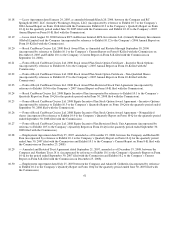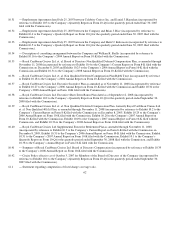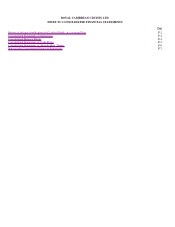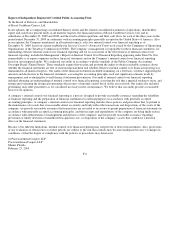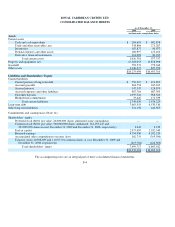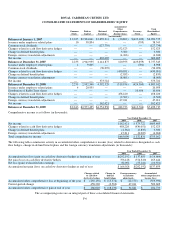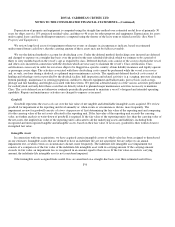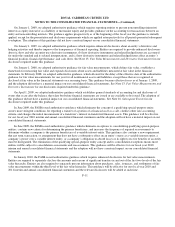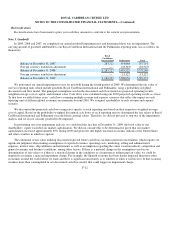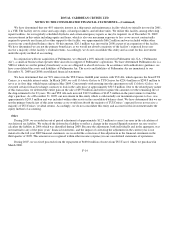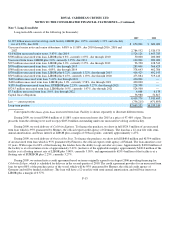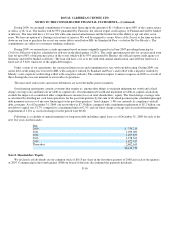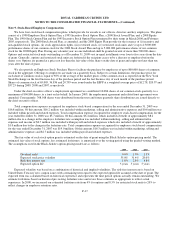Royal Caribbean Cruise Lines 2009 Annual Report Download - page 81
Download and view the complete annual report
Please find page 81 of the 2009 Royal Caribbean Cruise Lines annual report below. You can navigate through the pages in the report by either clicking on the pages listed below, or by using the keyword search tool below to find specific information within the annual report.
ROYAL CARIBBEAN CRUISES LTD.
NOTES TO THE CONSOLIDATED FINANCIAL STATEMENTS—(Continued)
Depreciation of property and equipment is computed using the straight-line method over estimated useful lives of primarily 30
years for ships, net of a 15% projected residual value, and three to 40 years for other property and equipment. Depreciation for assets
under capital leases and leasehold improvements is computed using the shorter of the lease term or related asset life. (See Note 5.
Property and Equipmen
t
.)
We review long-lived assets for impairment whenever events or changes in circumstances indicate, based on estimated
undiscounted future cash flows, that the carrying amount of these assets may not be fully recoverable.
We use the deferral method to account for drydocking costs. Under the deferral method, drydocking costs incurred are deferred
and charged to expense on a straight-line basis over the period to the next scheduled drydock which we estimate to be a period of
thirty to sixty months based on the vessel’s age as required by class. Deferred drydock costs consist of the costs to drydock the vessel
and other costs incurred in connection with the drydock which are necessary to maintain the vessel’s Class certification. Class
certification is necessary in order for our cruise ships to be flagged in a specific country, obtain liability insurance and legally operate
as passenger cruise ships. The activities associated with those drydocking costs cannot be performed while the vessel is in service
and, as such, are done during a drydock as a planned major maintenance activity. The significant deferred drydock costs consist of
hauling and wharfage services provided by the drydock facility, hull inspection and related activities (e.g. scraping, pressure cleaning,
bottom painting), maintenance to steering propulsion, stabilizers, thruster equipment and ballast tanks, port services such as tugs,
pilotage and line handling, and freight associated with these items. We perform a detailed analysis of the various activities performed
for each drydock and only defer those costs that are directly related to planned major maintenance activities necessary to maintain
Class. The costs deferred are not otherwise routinely periodically performed to maintain a vessel’s designed and intended operating
capability. Repairs and maintenance activities are charged to expense as incurred.
Goodwill
Goodwill represents the excess of cost over the fair value of net tangible and identifiable intangible assets acquired. We review
goodwill for impairment at the reporting unit level annually or, when events or circumstances dictate, more frequently. The
impairment review for goodwill consists of a two- step process of first determining the fair value of the reporting unit and comparing
it to the carrying value of the net assets allocated to the reporting unit. If the fair value of the reporting unit exceeds the carrying
value, no further analysis or write-down of goodwill is required. If the fair value of the reporting unit is less than the carrying value of
the net assets, the implied fair value of the reporting unit is allocated to all the underlying assets and liabilities, including both
recognized and unrecognized tangible and intangible assets, based on their fair value. If necessary, goodwill is then written down to
its implied fair value.
Intangible Assets
In connection with our acquisitions, we have acquired certain intangible assets of which value has been assigned to them based
on our estimates. Intangible assets that are deemed to have an indefinite life are not amortized, but are subject to an annual
impairment test, or when events or circumstances dictate, more frequently. The indefinite-life intangible asset impairment test
consists of a comparison of the fair value of the indefinite-life intangible asset with its carrying amount. If the carrying amount
exceeds its fair value, an impairment loss is recognized in an amount equal to that excess. If the fair value exceeds its carrying
amount, the indefinite-life intangible asset is not considered impaired.
Other intangible assets assigned finite useful lives are amortized on a straight-line basis over their estimated useful lives.
F-8


